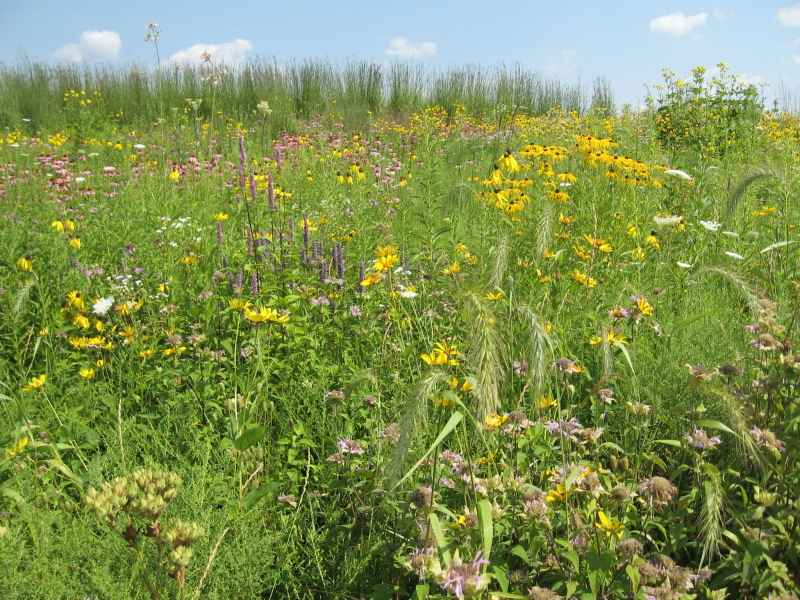 Prairie planted on the northwest side of Pheasant Branch Conservancy in 2001. View some of the plants visible in the picture on the plants website.
Prairie planted on the northwest side of Pheasant Branch Conservancy in 2001. View some of the plants visible in the picture on the plants website. Prairie planted on the northwest side of Pheasant Branch Conservancy in 2001. View some of the plants visible in the picture on the plants website.
Prairie planted on the northwest side of Pheasant Branch Conservancy in 2001. View some of the plants visible in the picture on the plants website.This page aims to give some of the history of how the prairies in the county portion of Pheasant Branch Conservancy came to be, and how the Friends of Pheasant Branch Conservancy are involved in their continuing restoration. For a general history of the entire conservancy, please see “Geology, Cultural History and Ecology of the Pheasant Branch Conservancy and Watershed” [F], a booklet produced for the 2005 tenth anniversary of the founding of the Friends.
This site was created in February of 2011 and updated in November of 2014.
Contents
Some 16,000 years ago, the northeastern two thirds of Dane county was buried under the western edge of what is now known as the Green Bay Lobe of the Johnstown phase of the Laurentide Ice Sheet. (Nearly all of the remaining portion of Dane county is part of the so called “Driftless Zone”, an area including southwestern Wisconsin that was never covered by glaciers during the last ice age.)
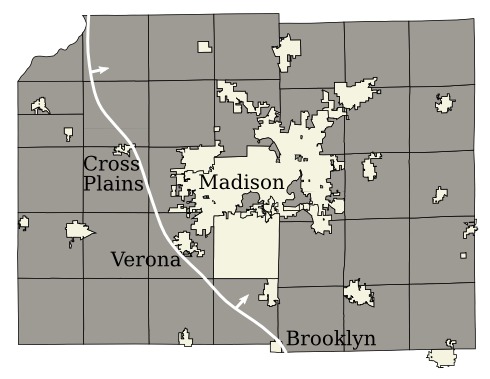 The white line shows the (approximate) maximum extent of the Johnstown phase of the Wisconsin glacier in Dane county [K1].
The white line shows the (approximate) maximum extent of the Johnstown phase of the Wisconsin glacier in Dane county [K1].As the glacier advanced through the area it scoured the earth of soil and plant material, so that when glaciers left southern Wisconsin some 13,000 years ago, no pre-glacial flora remained in the glaciated areas. As the glaciers retreated and the climate warmed, species that had survived the ice age in more temperate regions began to repopulate the glaciated areas. Post-glacial cool-climate forests eventually gave way to conditions in southern Wisconsin more favorable to grasslands, which reached their peak here during a relatively warmer period roughly 8,000-6,000 years ago. Since then the climate of southern Wisconsin has supported a shifting mix of prairie, savanna (a combination of prairie and scattered trees), and forest [CI, p. 22].
In addition to climate, the other major factor in the spread and maintenance of grasslands in Wisconsin was the presence of Native Americans. Native Americans arrived in southern Wisconsin about 12,000 years ago, and while not much is known of those early settlers, we do know that in more recent times Native Americans used nearly annual wide ranging fire as a tool for improving hunting grounds, among other things [CI, p. 21], [Py], [C, p. 461], [W]. The effect on grasslands was to stimulate fresh growth that would attract game animals, and to prevent such areas from converting back to brush and forest. More forested areas where fire was present were either converted to grassland (depending mostly on the species of trees present and the intensity of the fire) or the understory was thinned, leaving a more open forest or savanna. Today prescribed fires are used as a management tool in prairie restoration to much the same effect - see Prescribed fire below for more details.
For more information on the history of Native Americans in the Pheasant Branch area and the presence of Indian mounds at the conservancy, see [F, section III].
Land survey records conducted throughout Wisconsin from 1832-1866 give us our best estimates of the extent of prairie prior to major European settlement. They indicate that there were approximately 3.2 million acres of grassland in Wisconsin at the time, of which about 2.1 million acres (6% of total Wisconsin land area) was prairie and about 1 million acres was sedge meadow [C, p. 61]. Quoting Henderson and Sample [HS, p. 118]:
According to the State Natural Heritage Inventory, Wisconsin has only 0.5% (13,000 acres) of its original grassland ecosystem remaining in a relatively intact condition, and much of this remnant acreage has been degraded to some degree by livestock grazing or woody invasion. Over 80% (11,000 acres) of this remaining acreage is sedge meadow, and the rest (2,000 acres) is native prairie.
...
These remnants represent only 1.1% and 0.1% of the original sedge meadow and prairie acreage, respectively. Most of the surviving prairie is either dry or wet; the intermediate type (mesic prairie), once the most common type in the state, is now virtually gone. Only about 100 acres (0.01%) of an original million acres of mesic prairie are known to exist, and these are in small (often linear), scattered parcels of a few acres at best.
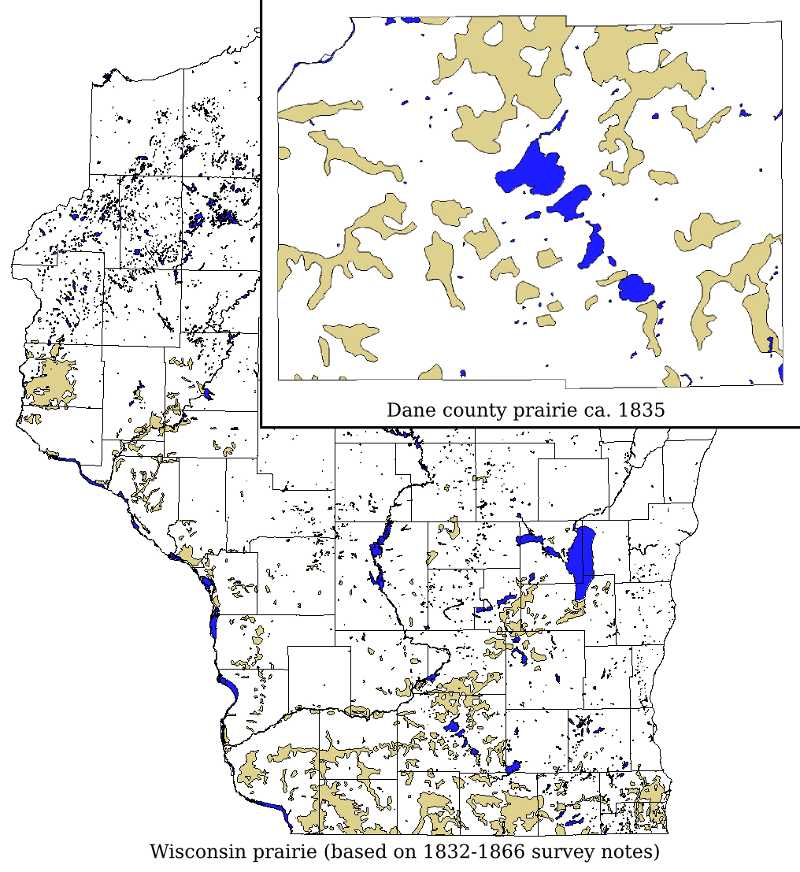 Map of Wisconsin and Dane county pre-European-settlement prairie based on survey records from 1832-1866 [K2].
Map of Wisconsin and Dane county pre-European-settlement prairie based on survey records from 1832-1866 [K2].Naturally occuring prairie that has been left largely untouched since European settlement is called remnant prairie. At Pheasant Branch there is a small parcel of dry remnant prairie on the southern and western portions of the hill, now called Frederick's Hill, that is visible from the county parking lot on Pheasant Branch Road.
 Remnant prairie on Frederick's Hill.
Remnant prairie on Frederick's Hill.Most of the dry remnant prairie in Wisconsin that has survived is situated on southwest-facing rocky slopes that are unsuitable for farming. The hot dry thin soils of dry prairies are also generally more capable of resisting encroachment of the shrubs and trees that tend to invade more moist prairies in the absence of fire.
Among the common species found on the remnant are leadplant (Amorpha canescens), big bluestem (Andropogon gerardi), little bluestem (Andropogon scoparius), pasque flower (Anemone patens), pussytoes (Antennaria plantaginifolia), rock sandwort (Arenaria stricta), whorled milkweed (Asclepias verticillata), Mead's sedge (Carex meadii), Richardson's sedge (Carex Richardsonii), downy yellow painted cup (Castilleja sessiliflora), bastard toadflax (Comandra umbellata), flowering spurge (Euphorbia corollata), western sunflower (Helianthus occidentalis), yellow star grass (Hypoxis hirsuta), hoary puccoon (Lithospermum canescens), fringed puccoon (Lithospermum incisum), pale spike lobelia (Lobelia spicata), Seneca snakeroot (Polygala senega), prairie rose (Rosa arkansana), prairie blue-eyed grass (Sisyrinchium campestre), Indian grass (Sorghastrum nutans), prairie dropseed (Sporobolus heterolepis), azure aster (Symphyotrichum oolentangiense), silky aster (Symphyotrichum sericeum), bird's foot violet (Viola pedata), and prairie violet (Viola pedatifida). View these plants on the plants website.
Considering the topography and soils of Frederick's Hill and the relatively stable climate over the past 5,000 years in Wisconsin, it's possible that prairie plants have been growing in that location for several thousand years!
The thin dry soils of the remnant are easily eroded, so it doesn't take much for improvised walking trails to form scars that would take years to recover. Please stay on the marked trails and help preserve this special area.
The account below is not intended as an authoritative treatment of prairie restoration techniques, but merely as a general description of parts of the prairie restoration process as they occur at Pheasant Branch. In all of our restoration activities in the county portion of the conservancy the Friends work under the guidance of Wayne Pauly, the Dane county naturalist.
In 1994 Dane county purchased the Frederick family farm, adding about 120 acres to the existing 340-acre Pheasant Branch Conservancy owned by the City of Middleton to the south. (The city and county now cooperate in management of the conservancy’s resources.) That property originally belonged to the Acker family, which still owns farms to the west and north of the conservancy. Purchased by the Frederick family in the 1880s, the land includes a hill on which cattle were grazed, cropland surrounding the hill, a large spring south of the hill, and several acres of marsh along its southern border (see the 1937 aerial photo below). When Mr. Frederick retired, his family chose to sell the land for conservation of its unique resources rather than sell it to developers. For more on the Frederick family history at Pheasant Branch, see [Pf].
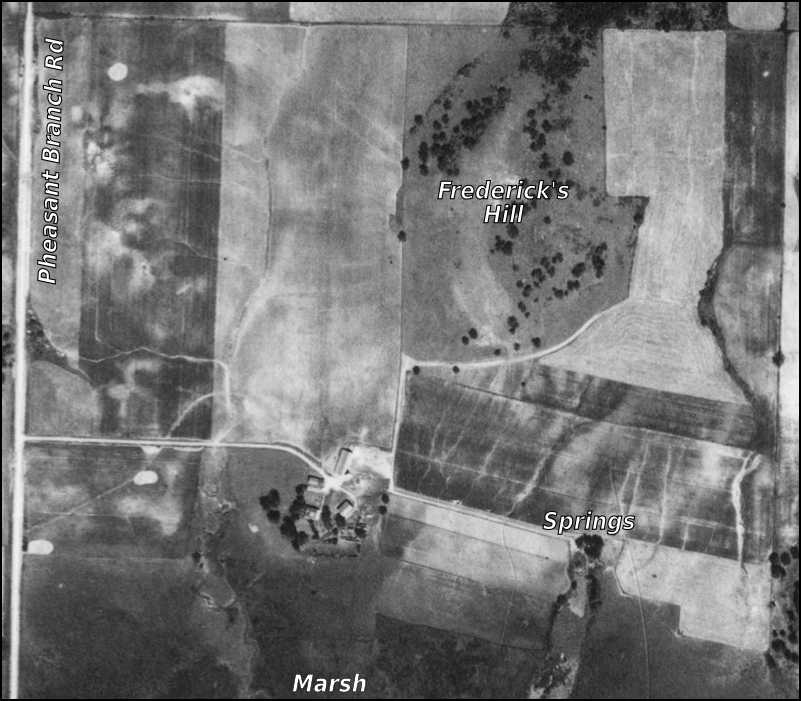 1937 aerial photo of the county portion of Pheasant Branch Conservancy. [I1]
1937 aerial photo of the county portion of Pheasant Branch Conservancy. [I1]When the county acquired the Frederick farm in 1994, some of the agricultural fields were left in crop production, but others had been left fallow and were mostly weeds. In 1997, the Friends of Pheasant Branch worked with Dane county naturalist Wayne Pauly to develop a twenty year plan for converting the old farm fields to prairie. Thanks to the dedication of Wayne and his staff, to help from hundreds of eager volunteers, and to many generous grants, seeding was completed in 2006, eleven years ahead of schedule!
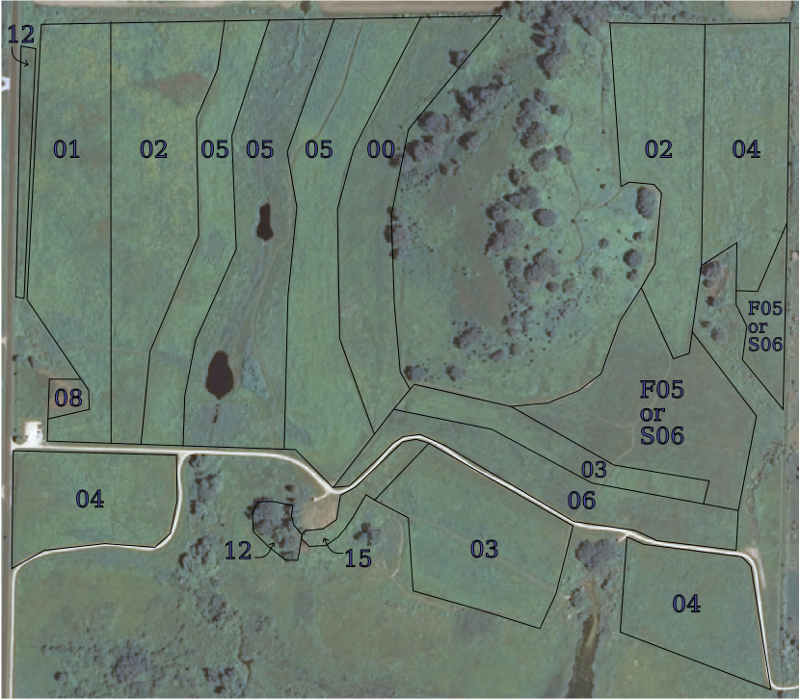 Years the different sections of prairie were planted. [K3]
Years the different sections of prairie were planted. [K3]Perhaps counterintuitively, some of the best preparation for prairie planting comes from several years of cropping prior to the planting. Tilling and herbiciding associated with planting annual food crops such as corn give a chance for the majority of the weed seeds in the soil to germinate and be killed, thereby limiting competition for newly sprouting prairie plants. As an added benefit, any plant material left on the ground after the last harvest acts as mulch for prairie seedlings the next spring to help keep them from drying out. At Pheasant Branch, nearly all of the fields converted to prairie had either been corn crops or were converted to corn crops prior to planting. The few remaining old fields that hadn't been in recent crop rotation were herbicided spring and fall for two years prior to planting.
The actual “planting” of the prairie seeds at Pheasant Branch, a total of 52 acres, was all done by a few members of Wayne Pauly's staff and lots of volunteers, and consisted simply of walking around and hand broadcasting seed onto the ground. Some plantings were done in the fall and some in the spring, with the number of species planted varying per planting from about 80 to 100. One reason to prefer planting in the fall is that seeds are allowed to overwinter naturally: in addition to providing a cold moist period necessary for some types of seed to germinate, frost heaving and snow melt help to incorporate seed into the soil.
The pattern of seed dispersal varies depending on the type of seed, with the primary determining factors being moisture requirements and aggressiveness of the species involved. For a number of less aggressive plants that will do well across a variety of moisture regimes, a mix is spread uniformly across the entire site. For other plants that are more aggressive or more specialized in terms of habitat and water needs, seed is dispersed in patches in areas appropriate to that plant. Planting in targeted patches instead of spread out evenly over an entire area serves several purposes. For one, patches of plants are easier to locate and work with for seed collection. Also, descriptions from early settlers describing the prairie indicate that many species grew in isolated clumps, so we're working to recreate natural conditions. One explanation for the natural grouping effect is that clumps of a given plant are probably more capable of resisting encroachment by more aggressive species than individuals would be. In other words, if a uniform mix of all of the available seeds was spread out evenly over an area, eventually the most aggressive species would probably take over most of the area. Also, having plants of a single species close together in a group makes it more likely that visiting insects will successfully pollinate plants in that group, thereby increasing seed production in the group and perpetuating its existence. You can pick out planted patches of several different species in the photo at the top of the page.
The hows and whys of where a particular species of plant tends to grow involve an extremely complex combinatin of factors, one of the most important general factors being soil moisture level. For discussion purposes, prairies are often roughly divided into five categories depending on their moisture level: wet (inundated each spring), wet-mesic (inundated, but more rarely), mesic (deep soil with good moisture, but not inundated), dry-mesic (dry but deep soils, often sandy), and dry (thin dry soils, over bedrock or gravel) [C, p. 58]. While some prairie species, such as big bluestem (Andropogon gerardii), are not uncommon (to varying degrees) across the entire spectrum of moisture conditions, others have more restrictive moisture requirements and will rarely be found outside of their comfort zone. The planted prairies at Pheasant Branch are mostly mesic, with some smaller areas of dry-mesic mixed in.
For a readable account of the prairies of Wisconsin by moisture gradient (and of the other vegetation types of Wisconsin), see Curtis' foundational Vegetation of Wisconsin [C].
Many prairie species invest most of their energy in their first few years to below ground growth, in some cases with several times deeper below ground growth than above ground. The development of deep roots is an adaptation of prairie plants that allows them to survive in the drought-prone climate characteristic of grassland regions. White wild indigo (Baptisia alba), as an extreme example, takes several years to develop above and below ground, but at maturity can sport a root system fifteen feet or more deep!
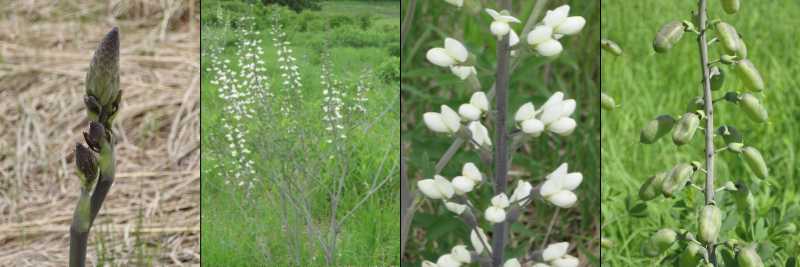 White wild indigo (Baptisia alba) from spring to late summer.
White wild indigo (Baptisia alba) from spring to late summer.As a result of an initial emphasis on root growth, prairie plantings have a tendency to look mostly like weed gardens in the first couple of years, during which time the quicker growing prairie plants are joined by opportunistic mostly annual or short-lived weeds that move in and colonize bare soil. But as the slower to develop prairie plants “get their roots under them”, so to speak, they begin to outcompete the weaker annuals for resources and the weeds tend to fade away. After five to eight years, successfully planted areas will display a colorful array of prairie plants from which seeds can be harvested.
Life being what it is, some prairie plantings never survive the weedy stage. Strips on either side of a north-south drainage ditch constructed in the '90s were planted as prairie, the same as the rest of the surrounding area, but the prairie plants didn't take. Perhaps dredging had introduced soil that was very different from the neighboring areas. Today those strips have reverted back to mostly common goldenrod (Solidago canadensis), giant ragweed (Ambrosia trifida), and smooth brome (Bromus inermis), all common weedy species that were never planted there (view them here). To paraphrase a wise man: “There are lots of things you can do to ruin a prairie planting, but there's nothing you can do to guarantee a planting will succeed.”
There are various definitions of what constitutes an invasive species, but here we just mean any species not native to the region. Some invasive species (under this definition) are relatively benign, while others, such as buckthorn (Rhamnus cathartica), honeysuckle (various Lonicera species), garlic mustard (Alliaria petiolata), or reed canary grass (Phalaris arundinacea), just as examples of some of the familiar invasives present in the conservancy (view them here), can do great harm to native populations, in many instances displacing native plants entirely and forming dense stands where nothing else grows (monocultures). In most instances, non-native species are not nearly so destructive in their native environment, where they may be controlled by insects or other herbivores, disease, or the presence of other competitive native plant populations. Invasive species are largely a recent phenomenom that first became widespread in the 1800s with increased transoceanic travel. Many species were brought to the U.S. from their native country as ornamentals, for erosion control, or for use as fencebreaks, and only later did their devastating effects in their new environment become apparent. Invasive honeysuckle (of which there are several species), a six to ten foot tall bush, is native to East Asia, but was introduced in America in 1896 as an ornamental, for wildlife cover, and for erosion control. Today many natural areas are overrun with honeysuckle, which forms a dense cover that crowds out and shades out most anything trying to grow beneath it.
Generally the more mature a prairie is the more capable it is of limiting the introduction of invasive species and their spread once they arrive, but some invasives are so aggressive that they are entirely capable, given the right conditions and absent intervention, of overtaking entire prairies. Members of the Friends and other volunteers work with the county naturalist, Wayne Pauly, to monitor the arrival of new invasives and to control the ones already here. In fact, now that the prairies have been planted, a large portion of the work done in the conservancy involves management of invasive species (although currently more of that work occurs on the savanna of the hill than on the prairies).
In recent years, the Friends have joined with caretakers from four other natural areas in hiring a group of five interns who work one full day a week at each of the five sites. At Pheasant Branch the interns work with Friends volunteers under the direction of Wayne Pauly, June through August, rain or shine! Recent work in the prairie included, among other things, controlling yellow and white sweet clover (Meliotus officinalis and Meliotus alba), bird's foot trefoil (Lotus corniculata), burdock (Arctium minus), plumeless thistle (Carduus acanthoides), and Queen Anne's lace (Daucus carota), all herbaceous (non-woody) invasives (view them here). Before the interns arrived, Friends volunteers worked on removing woody invasive honeysuckle and buckthorn in the prairie before they were hidden by spring growth.
Invasives are a great threat to restoration because they often have no native natural checks, but restorationists have to also deal with the fact that even some native species are capable of taking over large areas if left unchecked, especially if there has been some type of disturbance in the area. Most of these species spread vegetatively via rhizomes: underground horizontal stems that spread away from the original plant and then produce new above ground growth that looks like an entirely new plant. In fact if the rhizome breaks (as it sometimes naturally does) then the new plant is genetically identical to the original - in other words it's a clone, and plants that spread via rhizomes are called clonal. Such species may also reproduce and colonize new areas via seed, but locally their primary means of spreading is usually via rhizomes, with a single starter stem capable of leading to a clump of dozens or even hundreds of new stems produced via rhizomes. Native clonal prairie invaders at Pheasant Branch include Canada goldenrod (Solidago canadensis), smooth and staghorn sumac (Rhus glabra and Rhus hirta), gray dogwood (Cornus racemosa), and quaking aspen (Populus tremuloides) (view them here). The management goal with aggressive natives is to keep them in check so that less common more conservative species have a chance to take hold.
Some of the oldest and largest plants in the world are thought to be plants that have continually regrown and spread vegetatively. See for exmaple the story of Pando, a named clone of quaking aspen in Utah thought to weigh 6,000 tons and estimated to be at least 80,000 years old!
Very few of the species we work with can be killed simply by cutting once, so the primary means of control of both invasive and problematic native species is the use of herbicides. In the case of the two worst invasive woody species, buckthorn and honeysuckle, a single cut stem will in fact usually resprout as multiple stems, so, while cutting alone does temporarily set the plant back, it actually leads to more work later on. On such woody species the usual procedure is instead to cut the stems near ground level and then apply herbicide to the stumps to kill the plants.
Even assuming that all of the treated plants are killed, that still leaves a seed bank of seeds in the soil that have been dropping from the original plants for as long as they have been producing seed. Such seeds can survive in the soil, depending on the species and local conditions, anywhere from several years to several decades. Somewhat ironically, clearing the original plants that had been shading an area can give those seeds (or seedlings) the conditions they need to germinate and fill in the void left by the original plants, thus creating another round of plants requiring control. Restoration is not a one year process!
Historically, grasslands in Wisconsin and elsewhere were maintained by regular fires that would have spread great distances, stopped only by topographical features such as rivers and cliffs. Some fires would have been started by lightning strikes, but more regular (nearly annual) fires were started by Native Americans [CI, p. 21], for various reasons including, but not limited to, improved hunting [Py], [W].
Such fires either kill or retard tree and brush growth, but prairie plants maintain growing points below ground level that allow them to survive and quickly regrow after the brief heat of a typical prairie fire. In fact most prairie plants actually respond with vigor to the effects of fire, showing increased vegetative production and/or flowering in the season following a burn. Many non-native weedy species, on the other hand, are not adapted to fire, and while mostly not outright eradicated by fire, are often weakened or reduced in number. The densities of non-native non-woody plants are typically decreased by regular fire, while brushy species may be top-killed, i.e. above ground growth is killed and the plant is forced to start over from root stocks, typically rendering it unable to produce seed for several more years and preventing it from shading out nearby native species.
Today fire has been reintroduced to Pheasant Branch in the form of prescribed burns. Friends volunteers help to prepare the site for a prescribed burn by raking around oaks and other trees to help keep the fire from their trunks and are on hand the day of the burn to monitor trails and help direct traffic.
 Photos from during and after the prescribed fire of April 12, 2010. Note that the bur oaks in the last image are unharmed!
Photos from during and after the prescribed fire of April 12, 2010. Note that the bur oaks in the last image are unharmed!The value of such burns in knocking back invasives and invigorating existing native vegetation cannot be overestimated!
Different species of trees can have very different responses to fire. Maples, for example, are quite sensitive to fire: young saplings can be easily killed by even a low intensity fire. Bur oaks (Quercus macrocarpa), on the other hand, are quite resilient to the effects of fire. Mature bur oaks have thick bark ridges that protect the tree interior from the heat of a typical grassland fire burning along the ground, and younger oaks that are top-killed by fire are rarely completely killed by the fire, but instead are able to regrow from their below ground reserves [C, pp. 336, 300]. In fact at sites that receive regular fire, a young looking oak with perhaps only a couple feet of above ground growth could in fact be decades old! Black oaks (Quercus velutina), the other common oak on Frederick's Hill, don't have the thick bark of bur oaks but are also adapted to an environment with regular fire and are generally able to regrow when top-killed by fire. When we burn at Pheasant Branch we rake around any tree we want to protect just to be on the safe side.
An oak grove subject to regular fire results in the type of habitat historically present on most of Frederick's Hill, called oak savanna, which as a first approximation can be described as prairie-like ground cover interspersed with infrequent oaks. Oak savanna supports its own unique set of species adapted to the partial sun/partial shade environment below and around the oaks. Historically oak savanna was once present throughout much of southern Wisconsin, but today, as with prairies, the story is quite different - to quote Henderson and Sample [HS, p. 90]: "Intact examples of oak savanna vegetation are now so rare that less than 500 acres are listed in the Natural Heritage Inventory as having a plant assemblage similar to the original oak savanna. This is less than 0.01% of the original 5.5 million acres". For a fine local example of restored oak savanna, and for more information on savanna and prairie restoration, visit Pleasant Valley Conservancy outside Black Earth.
Over the past several decades, with the absence of fire on the hill and the encroachment of invasives from the surrounding area, large portions of Frederick's Hill were overgrown with honeysuckle, buckthorn, and other invasives. When the county acquired the property in 1994, the top of the hill was so overgrown with honeysuckle that the only way to get to the current day overlook of the marsh was to crawl on one's hands and knees through the brush! There has obviously been a lot of progress (see the comparison between 2000 and 2010 in the image below), but today much of the restoration effort in the county portion of the conservancy still involves clearing back invasives on the hill and reseeding with species appropriate to an oak savanna. Of course removing invasive seed sources from the hill also helps limit their spread to the surrounding prairie.
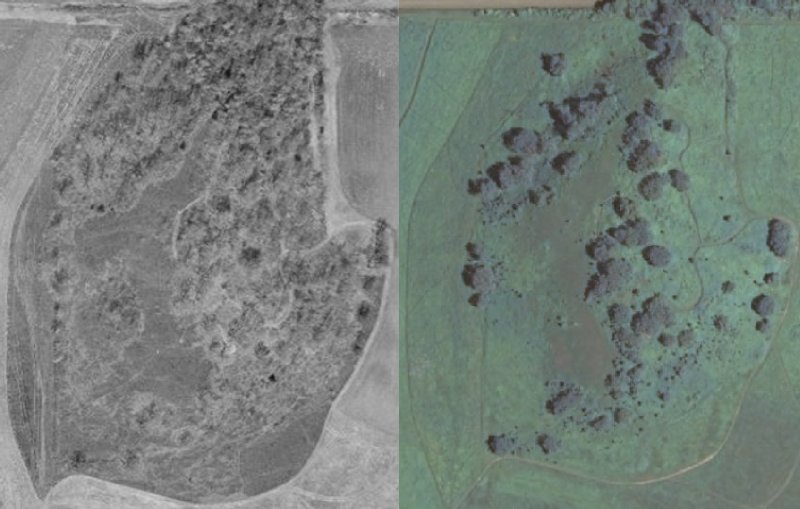 Frederick's Hill aerial photos from 2000 (left) and 2010 (right) - note the pervasive brush on the north and east sides of the hill in 2000! [K4]
Frederick's Hill aerial photos from 2000 (left) and 2010 (right) - note the pervasive brush on the north and east sides of the hill in 2000! [K4]Some of the original prairie seed that was planted at Pheasant Branch was purchased from grant money, but the vast majority came from seed that had been picked by volunteers from other already established prairies in Dane county. Today seed is collected at Pheasant Branch by hundreds of volunteers each year - some is resown at Pheasant Branch to fill in bare spots, but most is used to start more new prairies throughout Dane county. In recent years the county has provided the seed for planting or has itself planted an average of about 40 acres of new prairie per year from seed collected at sites like Pheasant Branch!
All of the seed is picked by hand. In some cases the seed can be pulled directly off of the plant in handfuls, while in other cases the part of the plant holding the seed has to either be broken off by hand or clipped off using hand clippers. The parts of a plant that are picked have already essentially completed their life cycle for the season, so plants aren't harmed by the process. Some seed is always left behind, whether it be as a result of seed falling during plant collection, not collecting all of the seed on a given plant, or missing plants all together, intentionally or otherwise. On a given day a group may collect seed from a dozen or more species, depending on the time of the year and the variety of species at a given location. Many species require careful timing for collection - too early and the seed won't be viable, too late and the plant will have already dropped most of its seed.
Each year the county brings school kids from throughout the area from third grade up through high school and college to experience the conservancy, learn a bit about the prairie, maybe hear a story from Wayne, and pick seed. Adult groups who volunteer through their employer are also regular seed collectors. In 2010 there were roughtly 350 kids and 150 adults who volunteered 1400 hours in the prairies collecting seed!
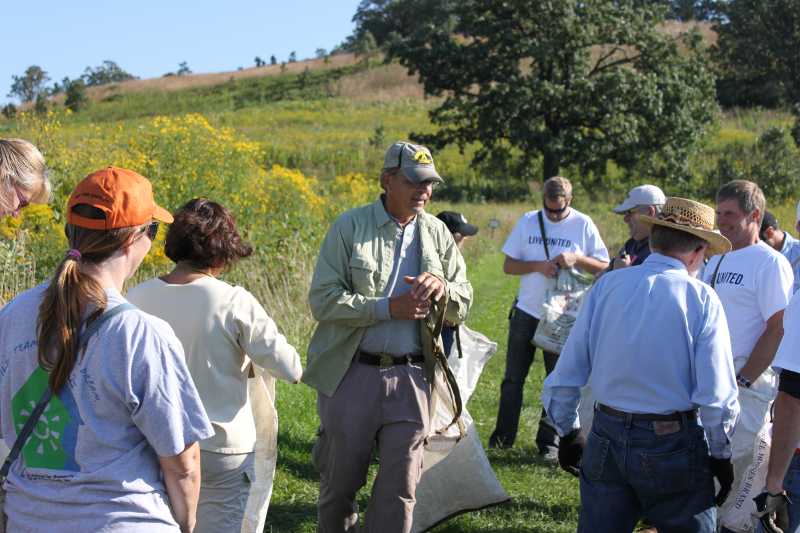 Wayne Pauly readies a United Way Day of Caring volunteer group for seed collecting.
Wayne Pauly readies a United Way Day of Caring volunteer group for seed collecting.Seed processing occurs during the fall and winter and is coordinated by Wayne Pauly with the help of his staff and volunteers at the Dane county garage. After collection, the bags of seed heads are left open with fans running in order to get the remaining plant material containing the seeds to dry out - if the bags were just sealed and left to sit the moisture in the plant material would build up and lead to rotting and eventually compromise the seed inside. After all of the plant material containing the seeds has dried out, the two-step process of seed extraction begins.
The first step consists of running the seed heads through a hammer mill to release the individual seeds from the plant material containing them. A hammer mill is a mechanical device that consists of a steel container about the size of a large coffee can on its side with a mesh screen on the bottom (mesh size depending on seed size) and metal bars that spin around inside the container. As plant material is fed into the container the spinning bars break up the dried plant material but the harder seed material is left unharmed, and as the material is broken down enough to fit through the mesh screen at the bottom it falls through into another bag.
The material from the hammer milling consists of a mix of broken up plant bits and seed, so the next step is to seperate the seed from the chaff. The separation is done using machines called fanning mills, originally used in farming for the same purpose with agricultural crops. The basic structure of a fanning mill consists of a sandwhich of two mesh screens arranged horizontally one over the other. The mesh sizes of the screens are chosen on a per species basis, with the top mesh size chosen so that only seed and smaller material will pass through, and the bottom mesh size chosen so that only material smaller than the seed will pass through.
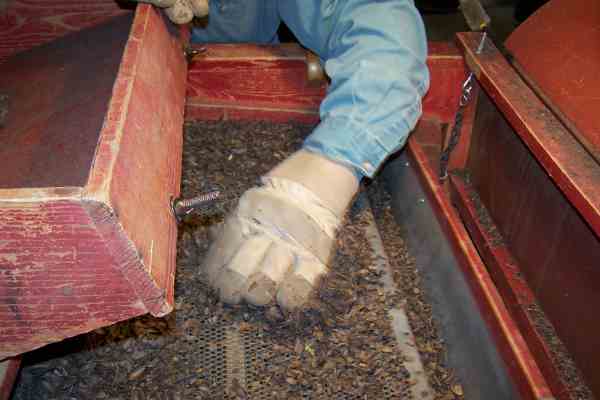 The top screen of the fanning mill.
The top screen of the fanning mill.The sandwhich is angled slightly down from the horizontal so that when the seed/chaff mix is placed at the top end of the top of the sandwhich and the mill is set to vibrating, the material slowly passes over the top screen. The larger bits never fall through the top screen but the smaller bits, including the seed, do. As that material vibrates over the second screen, material smaller than the seed falls through the screen and into a waste bin. When the remaining seed material, roughly all the same size, reaches the end of the bottom screen, it falls into a fanning chamber. As it falls through the chamber a horizontal fan of air blows the less dense plant material off to another waste bin, so that the only material remaining at the bottom of the fanning chamber is the denser seed. In practice certain types of seed may require several passes to remove all of the excess plant material.
The last step is to divide up the seed into individual bags destined for specific sites that year.
 Seed processing: from field, to hammer mill, to fanning mill, to clean seed ready to be planted. (The masks being worn in the pictures are for dust, as is the black tube in the upper right.)
Seed processing: from field, to hammer mill, to fanning mill, to clean seed ready to be planted. (The masks being worn in the pictures are for dust, as is the black tube in the upper right.)Each year Dane county produces about 700-800 pounds of clean seed!
If you'd like to get involved with restoration at Pheasant Branch, a great place to start would be to stop by for one of our scheduled work days throughout the year. Dates and times are listed at https://pheasantbranch.org/events/category/restoration-event/, but if you'd like to get reminders and find out what we'll be doing on a given day, please sign up to our email list by sending an email to restoration@pheasantbranch.org.
If you'd like to get involved with any part of seed collecting or processing, contact the Dane county parks volunteer coordinator Rhea Stangel-Maier at 608-224-3601 or Stangel-Maier@countyofdane.com. The county is always happy to meet new volunteers and there is probably a county prairie not too far from where you live that at some point may be getting some of the seed you process!
In any case, please consider becoming a member to support the ongoing work of the Friends in this special place.
[C]Curtis, John T. 1959. The Vegetation of Wisconsin: an Ordination of Plant Communities. University of Wisconsin Press, Madison.
[CI]Cochrane, Theodore S. and Hugh H. Iltis. 2000. Atlas of the Wisconsin Prairie and Savanna Flora. Wisconsin Department of Natural Resources Technical Bulletin 191.
[F]The Friends of Pheasant Branch Conservancy. 2005. Geology, Cultural History and Ecology of the Pheasant Branch Conservancy and Watershed in Middleton, Wisconsin. Pdf here.
[HS]Henderson, Richard and David Sample. 1995. Grassland communities. Pp. 116-129 in: Wisconsin Department of Natural Resources. Wisconsin's Biodiversity as a Management Issue: a Report to Department of Natural Resouces Managers. Wisconsin Department of Natural Resources Publication-RS-915 95. Madison.
[I1] Image downloaded from the Wisconsin Historic Aerial Image Finder, a service of the University of Wisconsin.
[K1] Map produced by Tom Klein using county GIS data downloaded from the (now defunct) DNR Webview (this may be the same dataset at its new location, I'm not sure), with the glacier line approximation based on the “Pleistocene geologic map of Dane county, Wisconsin”, available as a pdf at http://wgnhs.uwex.edu/pubs/download_b095plate01/ as part of Bulletin 95-DI.
[K2] Map produced by Tom Klein using “Wisconsin Original (Pre-Settlement) Vegetation Cover” GIS data downloaded from the Wisconsin DNR website at a page which no longer exists (this may be the same dataset, I'm not sure). The data represents the compilation by Robert W. Finley, 1976 Professor of Geography Emeritus, University of Wisconsin, of the vegetation cover of Wisconsin during the period 1832-1866 as determined by his examination of the US General Land Office's Public Lands Survey surveyors' notes from that time period (available online at http://digicoll.library.wisc.edu/SurveyNotes/).
Finley's original map is available online at http://dnr.wi.gov/topic/landscapes/maps.html - the map presented here is essentially just the prairie portion of that map.
[K3] Produced by Tom Klein. Aerial image cropped from the 2010 Dane county USDA-NAIP public domain aerial image available from the WisconView web portal; planting years from data provided by Wayne Pauly.
[K4] Produced by Tom Klein. The 2010 photo is the same as in [K3]; the 2000 photo is cropped from a Madison West DOQ map (entity DI00000001157781) downloaded from the USGS EarthExplorer website (this is probably the same as the 2000 Dane county aerial photo available from WisconsinView).
[Pf] Pfeiffer, Shaili. 2005. Recollections of the Frederick Family: Conserving the Springs. In the May 2005 Friends of Pheasant Branch Newsletter, pp. 7-8. Click here for a pdf copy of the article (0.7 megabyte).
[Py] Pyne, Stephen J. 1986. “These conflagrated prairies”: A cultural fire history of the grasslands. In Proc. Ninth North American Prairie Conference, ed. G. K. Clambey and R. H. Pemble, 131-137. Fargo, N.D.: Tri-College University Press.
[W] Williams, Gerald W. 2001. References On the American Indian Use of Fire In Ecosystems.